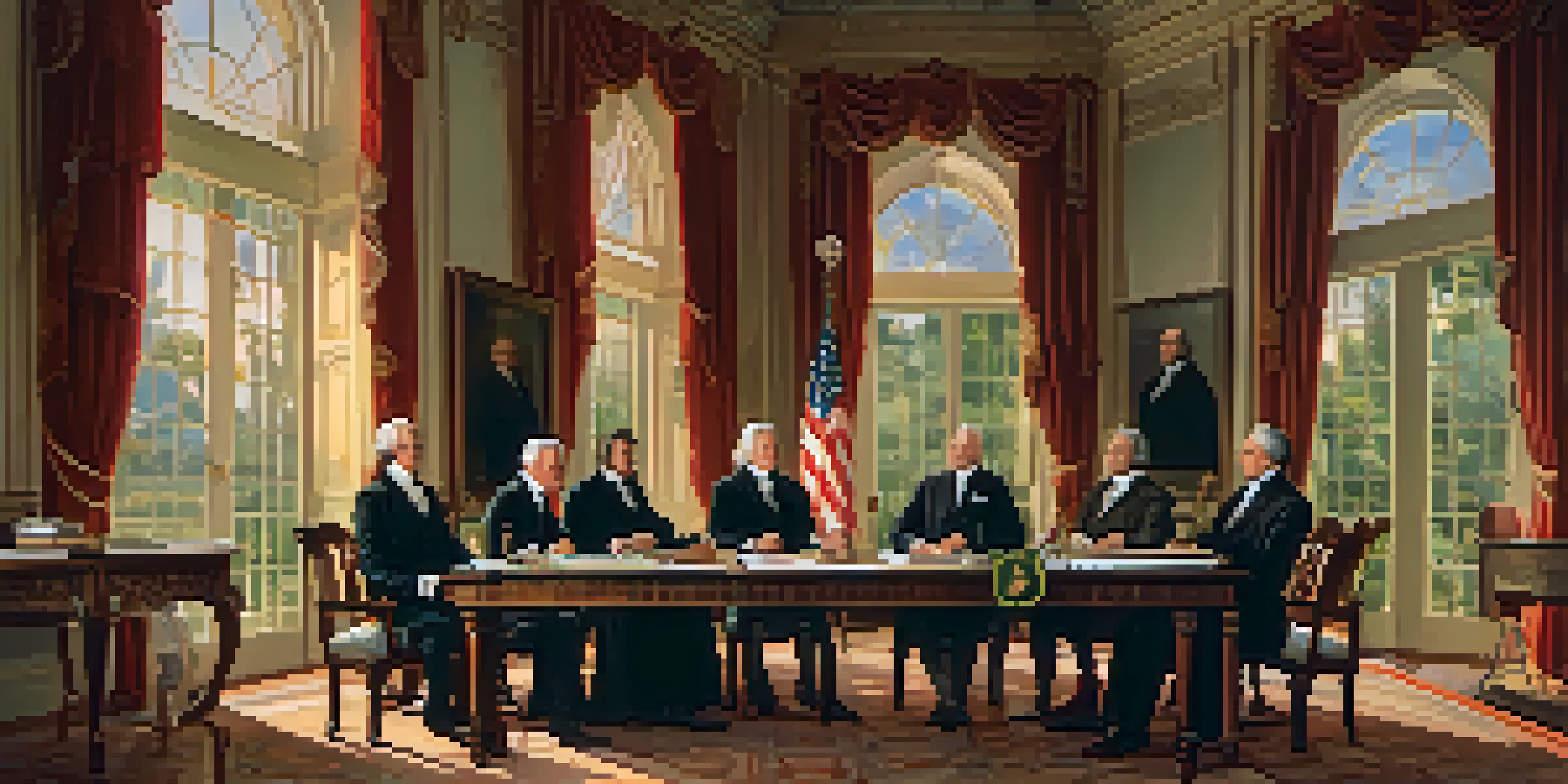Florida's Territorial Government: The Early Years of Governance

The Transition from Spanish Rule to Territorial Governance
Florida's governance took a pivotal turn in 1821 when it transitioned from Spanish control to becoming a U.S. territory. This change marked a significant shift in political and social dynamics, as local leaders began to navigate their new roles under American governance. The Treaty of Adams-Onís facilitated this transition, allowing the United States to assert its influence over the region.
The past is never dead. It's not even past.
With the arrival of American officials, there was an immediate effort to establish a structured government that reflected U.S. laws and values. The challenge was to integrate a diverse population that included Spanish settlers, Native Americans, and new American migrants. This merging of cultures created a unique governance landscape that would shape Florida's identity.
As the early territorial government took shape, it became essential for leaders to address local concerns while aligning with federal expectations. This balancing act set the stage for future governance challenges and opportunities, emphasizing the importance of adaptability in a rapidly changing political environment.
Establishing the First Government Structures in Florida
In the initial years following the transition, Florida's government focused on establishing foundational structures that would support civic order and community development. The first territorial legislature convened in 1822, laying down laws that would govern the territory. This legislative body was crucial in addressing local issues such as land disputes and law enforcement.

One of the early priorities was organizing a judicial system that could provide fair and consistent rulings. The establishment of courts helped to instill confidence in the new governance, offering residents a legal framework to resolve conflicts. This was particularly important in a territory with a mix of cultural backgrounds and legal traditions.
Transition to U.S. Territorial Rule
Florida shifted from Spanish control to U.S. governance in 1821, reshaping its political and social landscape.
Moreover, the territorial government worked on building infrastructure, such as roads and schools, to facilitate growth and connectivity. These early investments not only improved daily life but also attracted more settlers, signaling that Florida was a promising place for new opportunities.
The Role of the Governor in Early Territorial Florida
The role of the governor in Florida's early territorial government was pivotal in shaping policy and governance. Appointed by the president, the governor acted as the primary representative of federal authority while also being responsible for local administration. This dual role often placed governors in challenging positions, as they had to balance federal directives with the needs of the local populace.
History is not a burden on the memory but an illumination of the soul.
Governors like William P. Duval were instrumental in fostering relationships with various communities, including Native American tribes. Their ability to negotiate and communicate effectively helped to mitigate tensions and promote cooperation among diverse groups. This diplomatic approach was crucial in establishing a stable environment during a time of significant change.
Additionally, governors were tasked with implementing laws and managing the territory's resources. Their decisions would have lasting impacts, influencing everything from land policies to education systems, and setting precedents for future governance in Florida.
Legislation: Key Laws Shaping Early Florida Governance
Legislation passed in Florida's early territorial years laid the groundwork for future governance. The first laws addressed pressing issues such as land ownership, property rights, and the establishment of a legal framework. These laws were critical for ensuring order and promoting economic development in a newly formed territory.
One significant piece of legislation was the Land Act of 1820, which facilitated land sales and ownership for settlers. This act not only attracted new residents but also encouraged agricultural development, which became the backbone of Florida's economy. The focus on land ownership was a reflection of the American ideal of individualism and prosperity.
Establishment of Governance Structures
The formation of Florida's first territorial legislature and judicial system laid the groundwork for civic order and legal consistency.
Moreover, laws regarding education were also introduced, emphasizing the importance of literacy and knowledge for a thriving community. Establishing schools was seen as essential for fostering an informed citizenry, which in turn would support the democratic principles that the United States valued.
Interactions with Native American Tribes in Florida
The early governance of Florida was marked by complex interactions with Native American tribes, whose presence predated European settlement. As the U.S. government sought to exert control over the territory, it often found itself in conflict with indigenous populations. This tension highlighted the challenges of governance in a culturally diverse setting.
Treaties were a common method used by the government to manage relations with Native Americans. However, many of these agreements were not honored, leading to mistrust and resentment. The early territorial government had to navigate these delicate relationships carefully, understanding that cooperation was essential for stability.
Additionally, the government recognized that Native Americans held valuable knowledge about the land and its resources. Some governors attempted to foster partnerships, seeking to learn from tribal leaders while promoting coexistence. These efforts, though limited, were important steps toward acknowledging the contributions of Florida's original inhabitants.
The Impact of Migration on Florida's Governance
Migration played a significant role in shaping Florida's early governance, as waves of settlers brought diverse perspectives and needs. The influx of new residents from various states and countries introduced fresh ideas about governance, economy, and community development. This diversity enriched the cultural fabric of Florida but also posed challenges for the territorial government.
As more settlers arrived, the demand for land and resources increased, leading to tensions over property rights and access. The government had to adapt its policies to accommodate these new settlers while ensuring that existing residents were not marginalized. This balancing act was vital for maintaining social harmony in the territory.
Cultural Interactions and Migration
Early governance involved complex relationships with Native American tribes and adapting to the influx of diverse settlers, influencing local policies.
Moreover, the growth of communities spurred the need for local governance structures. As settlements expanded, residents sought representation and resources, prompting the creation of local governing bodies. This shift toward local governance was a precursor to Florida's eventual statehood, reflecting the evolving nature of political organization in the region.
Legacy of Florida's Early Territorial Government
The early years of Florida's territorial government left a lasting legacy that continues to influence the state today. The foundations laid during this period set the stage for Florida's transition to statehood in 1845. The governance structures, laws, and policies established in these years provided a framework for future leaders.
Moreover, the diverse interactions among settlers, Native Americans, and government officials fostered a unique cultural identity that remains a defining feature of Florida. This blending of traditions and perspectives contributed to a rich historical narrative that shapes the state's character.

Lastly, the challenges faced by the early government, from land disputes to cultural negotiations, serve as valuable lessons for contemporary governance. Understanding these historical contexts helps current leaders address modern issues, ensuring that Florida continues to grow while honoring its complex past.